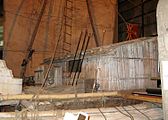
A maritime museum is a museum specializing in the display of objects relating to ships and travel on large bodies of water. A subcategory of maritime museums are naval museums, which focus on navies and the military use of the sea.
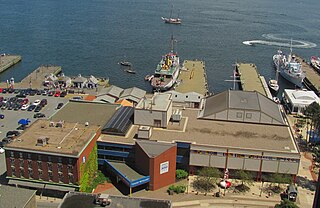
The Maritime Museum of the Atlantic is a maritime museum located in downtown Halifax, Nova Scotia, Canada.

The Kon-Tiki expedition was a 1947 journey by raft across the Pacific Ocean from South America to the Polynesian islands, led by Norwegian explorer and writer Thor Heyerdahl. The raft was named Kon-Tiki after the Inca god Viracocha, for whom "Kon-Tiki" was said to be an old name. Kon-Tiki is also the name of Heyerdahl's book, the Academy Award–winning 1950 documentary film chronicling his adventures, and the 2012 dramatized feature film nominated for the Academy Award for Best Foreign Language Film.

HMPNGS Lakekamu is Balikpapan-class landing craft heavy (LCH) operated by the Maritime Operations Element of the Papua New Guinea Defence Force (PNGDF). The vessel was one of eight built for the Royal Australian Navy (RAN) in the 1970s, and was commissioned into the RAN as HMAS Labuan in March 1973. Labuan was decommissioned in November 2014. She was transferred to the PNGDF for use as a training ship and was commissioned as HMPNGS Lakekamu in December 2014.

Ballina is a town in the Northern Rivers region of New South Wales, Australia, and the seat of the Ballina Shire local government area. Ballina's urban population at 2021 was 46,190. The town lies on the Richmond River and serves as a gateway to Byron Bay.

Sydney Heritage Fleet, is the trading name of Sydney Maritime Museum Ltd., a public (non-profit) company in Sydney, New South Wales, Australia.

Evans Head is a town in Richmond Valley Council of the Northern Rivers region of New South Wales, Australia. At the 2016 census, Evans Head had a population of 2,843 people. It is 726 kilometres north of Sydney, and 11 kilometres east off the Pacific Highway from Woodburn.

The Australian National Maritime Museum (ANMM) is a federally operated maritime museum in Darling Harbour, Sydney. After considering the idea of establishing a maritime museum, the federal government announced that a national maritime museum would be constructed at Darling Harbour, tied into the New South Wales state government's redevelopment of the area for the Australian bicentenary in 1988. The museum building was designed by Philip Cox, and although an opening date of 1988 was initially set, construction delays, cost overruns, and disagreements between the state and federal governments over funding responsibility pushed the opening to 1991.
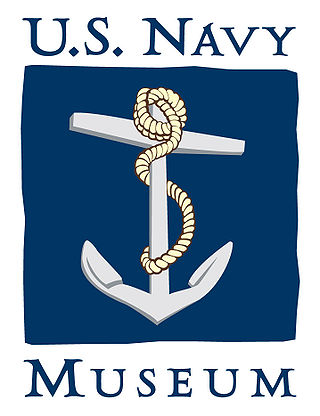
The National Museum of the United States Navy, or U.S. Navy Museum for short, is the flagship museum of the United States Navy and is located in the former Breech Mechanism Shop of the old Naval Gun Factory on the grounds of the Washington Navy Yard in Washington, D.C., United States.
There are numerous notable ships preserved in museums around the world. These are distinct from museum ships, which are ships where visitors can go aboard to see the ship.
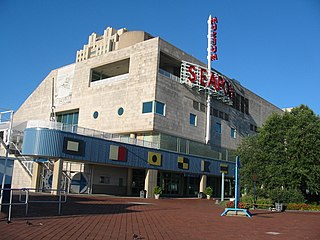
The Independence Seaport Museum was founded in 1961 and is located in the Penn's Landing complex along the Delaware River in Philadelphia, Pennsylvania. The collections at the Independence Seaport Museum document maritime history and culture along the Delaware River. At the museum are two National Historic Landmark ships and the J. Welles Henderson Archives and Library.
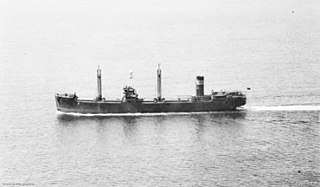
SS Iron Knight was a bulk carrier that was built in Scotland in 1937 for the Australian Broken Hill Pty, Ltd (BHP) to carry iron ore. A Japanese submarine sank her by torpedo off the coast of New South Wales in 1943, killing 36 of her crew. A wreck that was identified as that of Iron Knight is protected by the Australian federal Underwater Cultural Heritage Act 2018.

The United States Naval Academy Museum is a public maritime museum in Annapolis, Maryland, United States. A part of the United States Naval Academy, it is located at Preble Hall within the Academy premises. The museum has an area of 12,000 square feet (1,100 m2) with four galleries. It is currently headed by Director CDR Claude Berube, PhD USNR.

The Monmouth Museum, alternatively known as The Nelson Museum and Local History Centre, is a museum in Monmouth, Monmouthshire, south east Wales. It features a collection of artifacts associated with Admiral Horatio Nelson. The museum is located in the old Market Hall in the town centre in Monmouth, a short distance from the River Monnow, Monmouth Castle, and Agincourt Square.

The South African Naval Museum is a maritime museum in Simon's Town, South Africa. It contains collections and artefacts related to the maritime history of South Africa and the South African Navy.
Vital Alsar Ramírez was a sailor and scientist who made several extremely long sailing expeditions. His entire life was linked to nature and the sea. He became professor of economics, although he never acted as such.

The Naval Museum of Halifax is a Canadian Forces museum located at CFB Halifax in the former official residence of the Commander-in-Chief of the North America Station (1819–1905). Also known as the "Admiralty House", the residence is a National Historic Site of Canada located in Halifax, Nova Scotia, Canada. The museum collects, preserves and displays the artifacts and history of the Royal Canadian Navy.

Between 1966 and 1973, Spanish explorer Vital Alsar led three expeditions to cross the Pacific Ocean by raft – La Pacífica in 1966, La Balsa in 1970 and Las Balsas in 1973. Travelling from Ecuador, South America, to Australia, the first expedition failed, but the second and third succeeded, both setting the record for the longest known raft voyages in history – 8,600 miles (13,800 km) and 9,000 miles (14,000 km) respectively.
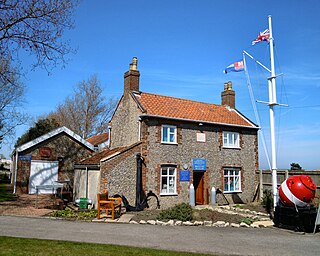
Lowestoft Maritime Museum is a private museum in the town of Lowestoft in Suffolk, England that is dedicated to local and national maritime history. Its exhibits include maritime artefacts including medals awarded to Royal Navy and RNLI personnel, marine art, the fishing industry in Lowestoft and the town's involvement with the Royal Navy in World War II, shipwrights and coopers tools, an extensive collection of ship models in various scales, the workshop of Christopher Cockerell, the inventor of the hovercraft, and a small display dedicated to Thomas Crisp, a local man who posthumously won the Victoria Cross during World War I. Britain's most easterly museum, it is run by enthusiasts and volunteers and is open to the public from late April to late October each year. The museum was the Suffolk Museum of the Year in 2012 and a finalist in 2014. There is an admission charge.
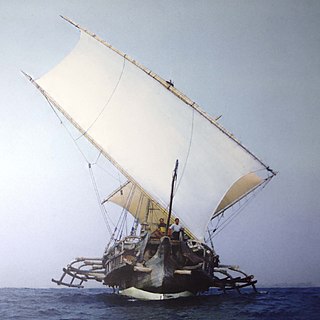
SamudraRaksa is a replica ship built in 2003 based on the relief of ships in the Borobudur temple. In the late 20th century, Philip Beale, a British sailor, became interested in depictions of the ship at Borobudur and decided to reconstruct one. Aided by government and international bodies, he organized an expedition team that constructed the ship and, from 2003 to 2004, sailed it from Indonesia to Madagascar and to Ghana, proving that long-distance trade could have occurred. The Samudra Raksa Museum was constructed at Borobudur Archeological Park to house the ship, opening in 2005, and provides other displays to interpret the ancient maritime history of Indonesians.


